Uganda’s grain industry players have called for urgent action to address persistent food safety challenges threatening the country’s food security and regional trade competitiveness.
This was during the Public-Private Engagement Forum on Food Safety and Trade Competitiveness in Uganda’s Grain Sector, hosted by the Eastern Africa Grain Council (EAGC) in partnership with the Confederation of Danish Industries (DI) at the Golf Course Hotel in Kampala.
The forum brought together key stakeholders from government ministries, the private sector, development partners, and academia to discuss policy, technology, and infrastructure solutions for safer and more competitive grain trade.
“Food contamination is costing us millions”
In his keynote address, Mr Herbert Kyeyamwa, the Country Director – Eastern Africa Grain Council and Managing Director-AgroWays Uganda Limited, underscored the scale of food contamination in Uganda’s grain sector, warning that the country continues to lose millions of dollars in potential export revenue due to unsafe grain.

“Over 60 percent of maize in previous years contained toxins above safe levels,” Kyeyamwa said. “Public health is at risk, trade is affected, and our economy is suffering. Uganda loses about USD 8 million annually in export and trade opportunities due to food contamination.”
He illustrated the real-world cost of contamination with a personal story about a wind turbine installation project that suffered heavy losses after contaminated dog feed led to the death of security dogs.
“That project was delayed by six months and cost an extra €36,000,” he said. “Contamination, though often overlooked, has very real, costly implications — just like what we’re seeing in the grain sector today.”

Kyeyamwa called for stronger implementation of Uganda’s National Action Plan for Aflatoxin Control (2019) and urged stakeholders to translate existing strategies into “actionable, funded, and monitored programs.”
“Uganda has immense agricultural potential, yet our doors to regional and international markets remain partially closed because of quality and safety issues,” he said. “We must bridge the infrastructure gap, adopt new technologies, and build partnerships that make food safety everyone’s responsibility.”
“If it’s not safe, it’s not food”
Paul Ochuna, Country Programs Manager for Uganda, Rwanda, and South Sudan at EAGC, provided an overview of the organisation’s regional work and the challenges undermining Uganda’s grain competitiveness.

“Aflatoxin contamination affects over 60% of maize, resulting in lost trade opportunities estimated at over USD 38 million,” Ochuna noted. “We’ve had repeated export rejections to Kenya and South Sudan — a sign of systemic failure, not isolated incidents.”
He highlighted the EAGC’s focus on structured trading systems, grain business hubs, and policy advocacy to strengthen the sector.
“Our message is simple — if it’s not safe, it’s not food,” Ochuna said. “Through partnerships and innovation, we can make Uganda’s grain sector safer, stronger, and globally competitive.”
“Government committed to ensuring food safety as a human right”
Representing the Ministry of Agriculture, Animal Industry and Fisheries (MAAIF), Dr Alexander Ssamula, Senior Inspector in the Department of Crop Inspection and Certification, emphasised government efforts to enhance grain quality and trade compliance.

“The government has implemented several interventions to ensure food safety — from subsidised inputs and mechanisation to expanding storage capacity and linking farmers with large-scale buyers,” Dr Ssamula said.
However, he acknowledged ongoing challenges, including limited laboratory infrastructure, low awareness, and inadequate financing for quality assurance.
“We are prioritising production through input support and post-harvest quality management,” he said. “Food safety is a fundamental human right. The Ministry is committed to working with all stakeholders to ensure Uganda’s agricultural products meet regional and international standards.”
“Partnerships are key to unlocking Uganda’s agricultural potential”
Speaking on behalf of the World Food Programme (WFP), Ian Figgins, Logistics Officer, linked Uganda’s grain safety agenda to global hunger and development goals.

“At WFP, we serve about 124 million people globally, but we can’t achieve Zero Hunger alone,” he said. “Partnerships are key — because if you want to go far, you must go together.”
Figgins emphasised Uganda’s vast agricultural potential, valued at USD 2.2 billion, and warned that food safety failures undermine this potential. “We’ve seen food exports rejected because of aflatoxin contamination,” he said. “By improving post-harvest handling, storage, and toxin management, Uganda can become a regional leader in food systems.”
He highlighted innovations such as ozone cleaning for grains, on-stalk drying, and safe input systems as promising tools in the fight against contamination.
“Sustainable solutions start with farmers”
Alex Njeru, Regional Project Manager at the Confederation of Danish Industries (DI), reiterated the importance of supporting farmers and small enterprises at the grassroots. “Anything that improves farmers’ livelihoods and strengthens the grassroots economy is close to my heart,” he said.

He outlined DI’s partnership with the Eastern Africa Development Fund (EADF), which has directly reached 365 farmers and trained over 14,000 participants in Kenya and Uganda.
“Our focus is on sustainable production, bio-solutions, and innovations such as solar-powered green grain drying systems,” Njeru explained. “We must continue promoting private sector-led policies and enterprise development that drive value addition and food safety.”
The forum was organised by the Eastern Africa Grain Council (EAGC) in partnership with the Confederation of Danish Industries (DI). It is part of a regional initiative to enhance food safety, aflatoxin control, and structured grain trade across East Africa. Participants included officials from MAAIF, UNBS, MTIC, and NARO, as well as private sector actors, processors, development partners, and grain business hubs.










